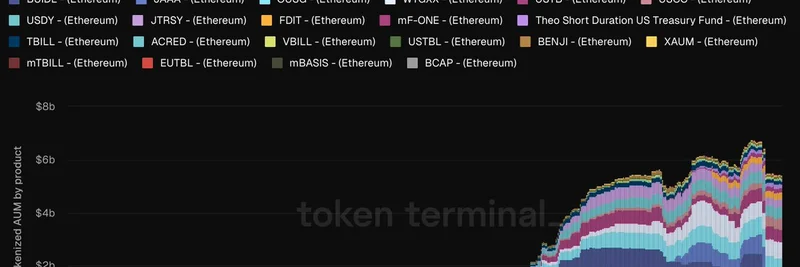In the fast-evolving world of blockchain, Ethereum continues to cement its position as a hub for innovative financial products. A recent post from Token Terminal highlights a staggering milestone: the assets under management (AUM) for tokenized funds on Ethereum have skyrocketed by approximately 2,000% since January 2024. This surge isn't just numbers on a chart—it's a sign of traditional finance giants like BlackRock and Fidelity embracing the blockchain, bringing their established funds directly onchain.
What Are Tokenized Funds?
For those new to the space, tokenized funds are essentially real-world assets (RWAs) like U.S. Treasuries, bonds, or other investment vehicles that get digitized into tokens on a blockchain. This process, known as tokenization, allows these assets to be traded, managed, and settled in a decentralized manner. Think of it as bridging the gap between traditional finance (TradFi) and decentralized finance (DeFi). On Ethereum, this means faster transactions, lower costs, and greater accessibility for investors worldwide.
The chart shared by Token Terminal breaks down the AUM growth by specific products, showing a stacked area graph that climbs from near zero to over $8 billion by late 2025. It's a visual testament to how quickly this sector is expanding.
Key Drivers Behind the Boom
The growth isn't happening in a vacuum. Major asset managers are the primary catalysts. BlackRock, one of the world's largest investment firms, has launched products like BUIDL, a tokenized fund backed by U.S. Treasuries. Similarly, Fidelity has introduced FDIT, focusing on similar onchain opportunities. These moves signal confidence in Ethereum's infrastructure, especially with upgrades like improved scalability and security features.
Other notable funds contributing to this rise include:
- JAAA (Ethereum-based fund)
- OUSG (Onchain U.S. Government Securities)
- WTGXX (Money market fund variant)
- And emerging players like USDC, USDY, and even specialized ones like mTBILL or XAUt for gold-backed assets.
This influx of institutional capital is transforming Ethereum from a speculative playground into a serious financial ecosystem. For blockchain practitioners, it means more liquidity, better yields, and new ways to integrate RWAs into DeFi protocols—potentially even influencing meme token strategies by providing stable backing or yield-generating collaterals.
Implications for the Broader Crypto Landscape
This trend has ripple effects across the crypto space. As more traditional assets go onchain, it could stabilize volatile markets, attract risk-averse investors, and boost overall adoption. For meme token enthusiasts, it's worth noting how this institutional push might create hybrid opportunities—imagine meme projects leveraging tokenized Treasuries for community treasuries or yield farming setups.
Ethereum's dominance in this area also underscores its edge over competitors, thanks to its robust smart contract capabilities and vast developer community. If you're building or investing in blockchain, keeping an eye on these metrics via platforms like Token Terminal can provide valuable insights into market shifts.
In summary, the 2,000% AUM spike is more than a stat—it's a harbinger of blockchain's maturation. As BlackRock and Fidelity pave the way, expect even more innovation in the tokenized fund space. Stay tuned to Meme Insider for more updates on how these developments intersect with the vibrant world of meme tokens and beyond.


